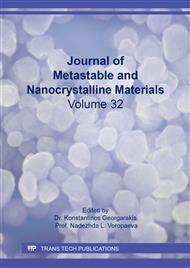[1]
A. Rámila, F. Balas, M. Vallet-Regí, Synthesis routes for bioactive sol−gel glasses: Alkoxides versus nitrates, Chem. Mater. 14(2) (2002) 542-548.
DOI: 10.1021/cm0110876
Google Scholar
[2]
Q.Z. Chen, D. Thompson, A.R. Boccaccini, 45S5 Bioglass®-derived glass–ceramic scaffolds for bone tissue engineering, Biomaterials. 27(11) (2006) 2414-2425.
DOI: 10.1016/j.biomaterials.2005.11.025
Google Scholar
[3]
N.F. Ibrahim, H. Mohamad, S. N. F. M. Noor, N. Ahmad, Melt-derived bioactive glass based on SiO2-CaO-Na2O-P2O5 system fabricated at lower melting temperature, J. Alloys Compd. 732 (2018) 603-612.
DOI: 10.1016/j.jallcom.2017.10.235
Google Scholar
[4]
D. C. Bell, K. Zhang, H. Yan, L. F. Francis, A. Stein, Three dimensionally ordered macroporous bioactive glasses. Microsc. Microanal. 8 (S02) (2002) 330-331.
DOI: 10.1017/s1431927602100900
Google Scholar
[5]
D. Bellucci, V. Cannillo, A. Sola, A new bioactive glass composition for bioceramic scaffolds, J. Ceram. Sci. and Technol. 1 (2010) 33-40.
Google Scholar
[6]
M. Vallet-Regi, Ordered mesoporous materials in the context of drug delivery systems and bone tissue engineering, Chem. Eur. J. 12(13) (2006) 5934-5943.
DOI: 10.1002/chem.200600226
Google Scholar
[7]
I. Izquierdo-Barba, M. Colilla, M. Vallet-Regi, Nanostructured mesoporous silicas for bone tissue regeneration, J. Nanomater. (2008) 1-14.
DOI: 10.1155/2008/106970
Google Scholar
[8]
S. Wang, Ordered mesoporous materials for drug delivery, Microporous and Mesoporous Mater. 117(1) (2009) 1-9.
Google Scholar
[9]
H. Yan, C. F. Blanford, W. H. Smyrl, A. Stein, Preparation and structure of 3D ordered macroporous alloys by PMMA colloidal crystal templating, Chem. Commun. 16 (2000) 1477-1478.
DOI: 10.1039/b003147j
Google Scholar
[10]
C. Triantafillidis, M.S. Elsaesser, N. Husing, Chemical phase separation strategies towards silica monoliths with hierarchical porosity, Chem. Soc. Rev. 42(9) (2013) 3833-3846.
DOI: 10.1039/c3cs35345a
Google Scholar
[11]
K. Nakanishi, T. Amatani, S. Yano, T. Kodaira, Multiscale templating of siloxane gels via polymerization-induced phase separation, Chem. Mater. 20(3) (2007) 1108-1115.
DOI: 10.1021/cm702486b
Google Scholar
[12]
S.G. Rudisill, S. Shaker, D. Terzic, R. Maire, B. L. Su, A. Stein, Generalized approach to the microstructure direction in metal oxide ceramics via polymerization-induced phase separation, Inorg. chem. 54(3) (2014) 993-1002.
DOI: 10.1021/ic5023856
Google Scholar
[13]
D. Li, Y.S. Lin, V.V. Guliants, Synthesis and characterization of ordered meso-macro-porous silica membranes on a porous alumina support, Tsinghu Sci. Technol. 15(4) (2010) 377-384.
DOI: 10.1016/s1007-0214(10)70076-6
Google Scholar
[14]
U. Boonyang, F. Li, A. Stein, Hierarchical structures and shaped particles of bioactive glass and its in vitro bioactivity, J. Nanomater. (2013) 1-6.
DOI: 10.1155/2013/681391
Google Scholar
[15]
S. H. Wu, C. Y. Mou, H. P. Lin, Synthesis of mesoporous silica nanoparticles, Chem. Soc. Rev. 42 (2013) 3862-3875.
Google Scholar


